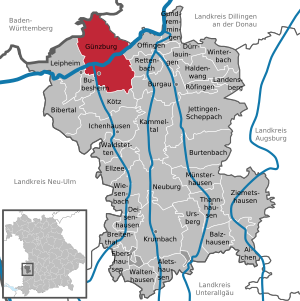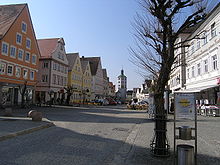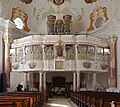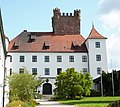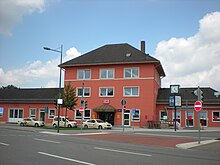Gunzburg
| coat of arms | Germany map | |
|---|---|---|

|
Coordinates: 48 ° 27 ' N , 10 ° 17' E |
|
| Basic data | ||
| State : | Bavaria | |
| Administrative region : | Swabia | |
| County : | Gunzburg | |
| Height : | 465 m above sea level NHN | |
| Area : | 55.41 km 2 | |
| Residents: | 21,028 (Dec. 31, 2019) | |
| Population density : | 380 inhabitants per km 2 | |
| Postal code : | 89312 | |
| Area code : | 08221 | |
| License plate : | GZ, KRU | |
| Community key : | 09 7 74 135 | |
| City structure: | 8 parts of the community | |
City administration address : |
Schloßplatz 1 89312 Günzburg |
|
| Website : | ||
| Lord Mayor : | Gerhard Jauernig ( SPD ) | |
| Location of the city of Günzburg in the district of Günzburg | ||
Günzburg is a large district town in the Swabian district of Günzburg .
The city is the administrative seat of the district of the same name, which was formed in 1972 from the independent city of Günzburg and the districts of Günzburg and Krumbach , and the seat of the district court of Günzburg .
geography
Günzburg is located at the confluence of the Günz and the Nau in the Danube at an altitude of 440-517 meters. The city is part of the Swabian Baroque Corner and Upper and Middle Swabia . In terms of natural space, it belongs to the Alpine foothills and the Danube-Iller-Lech-Platte ; the Donauried or Donaumoos begins north of the city .
There are 8 officially named municipal parts (the type of settlement is given in brackets ):
|
|
All parts of the municipality were independent municipalities before the territorial reform of the 1970s .
history
Origin of name and first written mentions
The "Burg / Stadt an der Günz " lies at the mouth of this river in the Danube. The name of the Günz is said to be derived from the Indo-European * gheu for "pour", meaning "water-rich river". Presumably it stems from the belief of the Celts that the goddess Gôntia lives in the river . The cult was adopted by the Romans . There was an inscription on a consecration stone with the text Gontiae sacr (um) - "consecrated to Gontia". The first written mentions were made:
- around 77/78 AD: building inscription of the older Roman fort (found around 1910, without mentioning the place name)
- 2nd / 3rd Century AD: consecration stone for the goddess Gôntia (found 1929)
- Beginning of the 3rd century: Mentioned in the street directory Itinerarium Antonini as Guntia
- at 297: in an eulogy for the regent Constantius Chlorus ( Panegyricus VIII. Incipit quartus, 2,1): "[...] usque ad Danubii transitum Guntiensem [...]")
- around 430: Mention of the military unit "Milites Ursariensis" in Guntiae in the Notitia dignitatum
- around 802: In "castellum Guntionis", according to the annals of the St. Emmeram monastery, "Cadaloc, Goterhammus and the many others were murdered".
- 1065: King Henry IV sealed a document to “ze Gunceburch”.
- 1242: A "dominus Hainricus de Guncenburch" is attested in the document register of the Bolzano notary Jakob Haas as a buyer of imported wine.
Prehistory, Antiquity and the Early Middle Ages
There are many traces of Celtic and other prehistoric and early historical settlements and burial places in the area (especially barrows and square entrenchments ). The castle hill of the Reisensburg district has been settled again and again since the Neolithic and is known as the "Swabian Acropolis". A chariot grave found in Leipheim indicates the presence of a Hallstatt-era prince's seat in the vicinity.
Günzburg itself was founded as a fort by the Romans to defend the Danube border. There were at least two successive castles: the first from around AD 77, the second after the border between the Rhaetian Limes and the Danube was withdrawn as a result of the Alemanni incursions of AD 260; they served to secure an important bridge over the Danube. This bridge was probably the last in Roman hands after the Alemanni storm - it seems to have been a well-known geographical term in the Roman world, it is mentioned as "Transitus Guntiensis" in an eulogy for the regent Constantius Chlorus . The forts were located in the area of today's Saint Martin Church . Travertine -Quader the late antique fortress were used for the construction of the church tower, also located such stones found in the construction of Günzbrücke.
Stationed in Gunzburg at the dawn Ala II Flavia milliaria , a 1,000-strong Roman elite - riders unit (later the unit of Heidenheim , then to Aalen moved). In late antiquity , the fortress was occupied by the "Milites Ursariensis", a respected troop of unknown origin and weapon type under the Dux Raetiae - the unit probably consisted to a large extent of federated Teutons . It is believed that Guntia was also a base of the Roman Danube fleet. In addition to the fort, a larger, at times quite prosperous civil settlement ( vicus ) developed with good integration into the Roman highway network. The results of the extensive excavations of Roman burial sites can be viewed in the local history museum. It is one of the largest excavated Roman burial grounds north of the Alps (several thousand burials). In 2013, during excavations, a mighty warehouse dated to the year 90 AD was discovered, the foundations of which were made of oak. The coin series of the Günzburg excavations ranges from Emperor Augustus to Anastasius .
Around 488 Odoacer ordered the Romans to withdraw from Raetia , although it is unclear to what extent this order was obeyed in the region. Presumably at least some Romans or Romans and Celts stayed behind, since the nearby settlements Waldstetten and Waldkirch were identified as places where Walchen and Welsche settled. From 493 on, the Ostrogoths had at least formally suzerainty in this area . These settled Alemannic settlers from 506 as border guards against the Franks . These probably mixed with the still resident Celts, Romans and the remaining Germanic auxiliary troops. In 536 the Ostrogoths had to cede the area to the Franks. A Franconian royal court probably existed at the site of the Roman forts, the substructure of the church tower of St. Martin is said to be a remnant of this court. The nearby Reisensburg Castle was mentioned as "Ricinis" as early as 600 by the " Geographer of Ravenna " as one of the most important castles of Alemannia. In Frankish Gausystem Gunzburg was probably a part of the Duria-Gaus .
Austrian outpost
In 1301, after the Counts of Berg died out - an ancient noble family related by marriage to the Staufers and to whom the title of margrave was awarded - the town came into the possession of the House of Austria / Habsburg as a "settled imperial fief" , which made Günzburg the capital of the Margraviate of Burgau . Soon after it was taken over by the Habsburgs, the (Roman) lower town, which was originally located in the valley where the Günz meets the Danube, was expanded to include an "upper town" built on a Riedel promontory , which quickly outstripped the "lower town" due to the relocation of the market. In 1418 the city received high jurisdiction .
In 1418 Günzburg and the margraviate were to be sold to Bavaria due to lack of money , but this was prevented by the imperial cities of Augsburg and Ulm as well as other members of the Swabian Confederation - through corresponding financial compensation to Austria. Even in later times, Günzburg and the margraviate could always count on the willingness of the imperial cities of Augsburg and Ulm, the Bishop of Augsburg and the Fugger family to keep the Bavarian dukes' desire for land west of the Lech in check.
When the Jewish community was expelled from Ulm at the end of the 15th century , most of them came to Günzburg. They settled where Münzgasse and Eisenhausgasse lead to Schweinchenbrunnen today and founded one of the most important centers of South German Jewry . The Günzburg Jewish community had its heyday in the 16th century. The headmaster Simeon ben Eliezer (* 1506 Günzburg, † 1585 Burgau), called Simon von Günzburg , was in close contact with Karl V. Members of the community emigrated to Frankfurt am Main and founded the successful trading company "Stadt Günzburg", which up to existed in the 19th century. (See also Jewish community Günzburg )
Very close to Günzburg, the Leipheimer Haufen (around 5,000 farmers) was massacred by the army of the Swabian Federation during the German Peasants' War in 1525 .
From 1609 to 1618 the city was the residence of Margrave Karl von Burgau , a strict Catholic and son of Ferdinand II in Tyrol, governor of Upper Austria . His father had a large castle built for him by the Italian master builder Alberto Lucchese from 1577–1580. In 1617 the margrave ordered the expulsion of the Günzburg Jewish community within a year (the common Jewish surnames Ginsburg , Gainsbourg , Ginsberg , Ginzberg , Ginzburg etc. mostly refer to descendants of this community). Karl and his wife Sybille had no children, so that Günzburg fell back to the main Habsburg line. Both were buried in the Capuchin monastery founded by Karl in 1616 .
The city suffered severe damage in the Thirty Years War . Of the more than 2,400 inhabitants, only one in three experienced the end of this catastrophic war, some smaller surrounding villages (such as Kleinkötz ) were hit even harder. In 1703, during the War of the Spanish Succession, the castle and 26 neighboring houses burned down.

Another city fire in 1735, during which 176 houses were destroyed, hit the city hard. However, doing only the construction was Frauenkirche of Dominic Zimmermann allows a masterpiece of Rococo . Empress Maria Theresa was very well disposed to the city; during their reign a successful mint was built, among other things. This is where the Maria Theresa thaler , the most popular silver coin in the world, was minted until the end of Austrian rule . The thalers minted in Vienna to this day still bear the Günzburg mint master mark “SF” (initials of the mint masters Tobias Schöbl and Joseph Faby ). The school system was also reorganized through the appointment of the Piarists and the English Misses , who still maintain a secondary school and a grammar school for girls in the city.
The trading companies Brentano , Molo and Rebay from the Lake Como area had branches in Günzburg since the early 18th century . They bought the raw canvas produced here, bleached it on the bleaching meadows leased by the city (along the Günz) and resold the goods that had been tested for quality (for a city fee). By founding a Danube shipping company with regular ships ( plattens ) to Vienna , Günzburg was also connected to the eastern parts of the Habsburg Empire by water . Many people who wanted to emigrate (today known as Danube Swabians ) to the Hungarian Banat were embarked here.
| The Danube flows and flows again - Danube Swabian folk song from the time of the settlement of Hungary | |
|---|---|
|
|
Emperor Joseph II made Günzburg a garrison . For this purpose, Joseph Dossenberger built the Rococo barracks, which is now used as the “House of Education” (adult education center, technical college) at the southeast end of the upper town , and the commandant's office on Augsburger Strasse .
On May 18, 1803, Günzburg became the provincial capital of Upper Austria , which covered large areas of the old Duchy of Swabia . On October 9, 1805 there was heavy fighting at the Günzburg Danube bridges in the course of the Third Coalition War and in the run-up to the Battle of Elchingen . A few days later, when Napoleon dismissed the city's dignitaries in the Günzburg town hall, he finally mentioned the reason why the city on the Danube became a theater of war: “C'est un malheur d'être à l'Autriche!” - “It is just a misfortune to belong to Austria ”.
Belonging to Bavaria
After the Peace of Pressburg , the city became Bavarian in 1806 . Since Günzburg lost the status of an Austrian state capital and the residents had dislike for Bavaria for centuries, this news was received rather negatively by the residents. Pastor Feuchtmayer to have preached on New Year 1806: "So now we are become Bavarian - probably we did not deserve better because of our sins." For years, refused the Günzburger, the Austrian shield of the coat of arms to be removed and instead the Bavarian diamonds to take over (1812).
The completion of the Munich-Stuttgart railway line (1853, " Bavarian Maximiliansbahn ") marked the beginning of industrial production in Günzburg and the surrounding area. This was followed by the connection to the Danube Valley Railway and in 1892 the opening of the Mittelschwabenbahn , which connects Günzburg with Krumbach and Mindelheim .
The newly developed Messerschmitt Me 262 air force aircraft made its maiden flight at Leipheim Air Base in 1942 . In April 1945, at the end of the Second World War , the city was bombed by Allied air forces. Among other things, the Denzingen district, the castle and an ammunition train that was parked in the station were badly hit or destroyed.
Incorporations
The previously independent municipality of Nornheim was incorporated as part of the municipal reform on July 1, 1972. On May 1, 1978 Deffingen, Denzingen, Leinheim, Reisensburg, Riedhausen and Wasserburg were added.
Population development
Günzburg grew from 1988 to 2008 by 1386 inhabitants or about 8%. Between 1988 and 2018 the city grew from 18,303 to 20,707 by 2,404 inhabitants or 13.1%. The population figures from 1840 onwards relate to today's municipality area (as of 1978).
| Population development | |||||||||||||||||||||||||||||||||||||||||||||||||||||||||||||||||||||||||||||||||||||||||||||||||||||||||||||||||||||||||||||||||||||||||||||||||||||||||||||||||||||||||||||||||||||||||||||||||||||||||||||||||||||||||||||||||||||||||||||||||||||||||||||||||||||||||||||||||||||||||||||||||||||||||||||||||||||||||||||||||||||||||||||||||||||||||||||||||||||||||||||||||||||||||||||||||||||||||||||||||||||||||||||||||||||||||||||||||||||||||||||||||||||||||||||||||||||||||||||||||||||||||||||||||||||||||||||||||||||||||||||||||||||||||||||||||||||||||||||||||||||||||||||||||||||||||||||||||||||||||||||||||||||||||||||||||||||||||||||||||||||||||||||||||||||||||||||||||||||||||||||||||||||||||||||||||||||||||||||||||||||||||||||||||||||||||||||||||||||||||||||||||||||||||||||||||||||||||||||||||||||||||||||||||||||||||||||||||||||||||||||||||||||||||||||||||||||||||||||||||||||||||||||||||||||||||||||||||||||||||||||||||||||||||||||||||||||||||||||||||||||||||||||||||||||||||||||||||||||||
|---|---|---|---|---|---|---|---|---|---|---|---|---|---|---|---|---|---|---|---|---|---|---|---|---|---|---|---|---|---|---|---|---|---|---|---|---|---|---|---|---|---|---|---|---|---|---|---|---|---|---|---|---|---|---|---|---|---|---|---|---|---|---|---|---|---|---|---|---|---|---|---|---|---|---|---|---|---|---|---|---|---|---|---|---|---|---|---|---|---|---|---|---|---|---|---|---|---|---|---|---|---|---|---|---|---|---|---|---|---|---|---|---|---|---|---|---|---|---|---|---|---|---|---|---|---|---|---|---|---|---|---|---|---|---|---|---|---|---|---|---|---|---|---|---|---|---|---|---|---|---|---|---|---|---|---|---|---|---|---|---|---|---|---|---|---|---|---|---|---|---|---|---|---|---|---|---|---|---|---|---|---|---|---|---|---|---|---|---|---|---|---|---|---|---|---|---|---|---|---|---|---|---|---|---|---|---|---|---|---|---|---|---|---|---|---|---|---|---|---|---|---|---|---|---|---|---|---|---|---|---|---|---|---|---|---|---|---|---|---|---|---|---|---|---|---|---|---|---|---|---|---|---|---|---|---|---|---|---|---|---|---|---|---|---|---|---|---|---|---|---|---|---|---|---|---|---|---|---|---|---|---|---|---|---|---|---|---|---|---|---|---|---|---|---|---|---|---|---|---|---|---|---|---|---|---|---|---|---|---|---|---|---|---|---|---|---|---|---|---|---|---|---|---|---|---|---|---|---|---|---|---|---|---|---|---|---|---|---|---|---|---|---|---|---|---|---|---|---|---|---|---|---|---|---|---|---|---|---|---|---|---|---|---|---|---|---|---|---|---|---|---|---|---|---|---|---|---|---|---|---|---|---|---|---|---|---|---|---|---|---|---|---|---|---|---|---|---|---|---|---|---|---|---|---|---|---|---|---|---|---|---|---|---|---|---|---|---|---|---|---|---|---|---|---|---|---|---|---|---|---|---|---|---|---|---|---|---|---|---|---|---|---|---|---|---|---|---|---|---|---|---|---|---|---|---|---|---|---|---|---|---|---|---|---|---|---|---|---|---|---|---|---|---|---|---|---|---|---|---|---|---|---|---|---|---|---|---|---|---|---|---|---|---|---|---|---|---|---|---|---|---|---|---|---|---|---|---|---|---|---|---|---|---|---|---|---|---|---|---|---|---|---|---|---|---|---|---|---|---|---|---|---|---|---|---|---|---|---|---|---|---|---|---|---|---|---|---|---|---|---|---|---|---|---|---|---|---|---|---|---|---|---|---|---|---|---|---|---|---|---|---|---|---|---|---|---|---|---|---|---|---|---|---|---|---|---|---|---|---|---|---|---|---|---|---|---|---|---|---|---|---|---|---|---|---|---|---|---|---|---|---|---|---|---|---|---|---|---|---|---|---|---|---|---|---|---|---|---|---|---|---|---|---|---|---|---|---|---|---|---|---|---|---|---|---|---|---|---|---|---|---|---|---|---|---|---|---|---|---|---|---|---|---|---|---|---|---|---|---|---|---|---|---|---|---|---|---|---|---|---|---|---|---|---|---|---|---|---|---|---|---|---|---|---|---|---|---|---|---|---|---|---|---|---|---|---|---|---|---|---|---|---|---|---|---|---|---|---|---|---|---|---|---|---|---|---|---|---|---|---|---|---|---|---|---|---|---|---|---|---|---|---|---|---|---|---|---|---|---|---|---|---|---|---|---|---|---|---|---|---|---|---|---|---|---|---|---|---|---|---|---|---|---|---|---|---|---|---|---|---|---|---|---|---|---|---|---|---|---|---|---|---|---|---|---|---|---|---|---|---|---|---|---|---|---|---|---|---|---|---|---|---|---|---|---|---|---|---|---|---|---|---|---|---|---|---|---|---|---|---|---|---|---|---|---|---|---|---|---|---|---|---|---|---|---|---|---|---|---|---|---|---|---|---|---|---|---|---|---|---|---|---|---|---|---|---|---|---|---|---|---|---|---|---|---|---|---|---|---|---|---|---|---|---|---|---|---|---|---|---|---|---|---|---|---|---|---|---|---|---|---|---|---|---|---|---|---|---|---|---|---|---|---|---|---|---|---|---|---|---|---|---|---|---|---|---|---|---|---|---|---|---|---|---|---|---|---|---|---|---|---|---|---|---|---|---|---|---|---|---|---|---|---|---|---|---|---|---|---|---|---|---|---|---|---|---|---|---|---|---|---|---|---|---|---|---|---|---|---|---|---|---|---|---|---|---|---|---|---|---|---|---|---|---|---|---|---|---|---|
| year | 1840 | 1900 | 1939 | 1950 | 1961 | 1970 | 1987 | 1988 | 1991 | 1995 | 2000 | 2005 | 2010 | 2015 | 2017 | 2018 | |||||||||||||||||||||||||||||||||||||||||||||||||||||||||||||||||||||||||||||||||||||||||||||||||||||||||||||||||||||||||||||||||||||||||||||||||||||||||||||||||||||||||||||||||||||||||||||||||||||||||||||||||||||||||||||||||||||||||||||||||||||||||||||||||||||||||||||||||||||||||||||||||||||||||||||||||||||||||||||||||||||||||||||||||||||||||||||||||||||||||||||||||||||||||||||||||||||||||||||||||||||||||||||||||||||||||||||||||||||||||||||||||||||||||||||||||||||||||||||||||||||||||||||||||||||||||||||||||||||||||||||||||||||||||||||||||||||||||||||||||||||||||||||||||||||||||||||||||||||||||||||||||||||||||||||||||||||||||||||||||||||||||||||||||||||||||||||||||||||||||||||||||||||||||||||||||||||||||||||||||||||||||||||||||||||||||||||||||||||||||||||||||||||||||||||||||||||||||||||||||||||||||||||||||||||||||||||||||||||||||||||||||||||||||||||||||||||||||||||||||||||||||||||||||||||||||||||||||||||||||||||||||||||||||||||||||||||||||||||||||||||||||||||||||||||||
| Residents | 5,245 | 6,725 | 9,527 | 13,877 | 15,710 | 17,820 | 18,217 | 18.303 | 19,266 | 19,489 | 19,599 | 19,748 | 19,561 | 20,038 | 20,355 | 20,707 | |||||||||||||||||||||||||||||||||||||||||||||||||||||||||||||||||||||||||||||||||||||||||||||||||||||||||||||||||||||||||||||||||||||||||||||||||||||||||||||||||||||||||||||||||||||||||||||||||||||||||||||||||||||||||||||||||||||||||||||||||||||||||||||||||||||||||||||||||||||||||||||||||||||||||||||||||||||||||||||||||||||||||||||||||||||||||||||||||||||||||||||||||||||||||||||||||||||||||||||||||||||||||||||||||||||||||||||||||||||||||||||||||||||||||||||||||||||||||||||||||||||||||||||||||||||||||||||||||||||||||||||||||||||||||||||||||||||||||||||||||||||||||||||||||||||||||||||||||||||||||||||||||||||||||||||||||||||||||||||||||||||||||||||||||||||||||||||||||||||||||||||||||||||||||||||||||||||||||||||||||||||||||||||||||||||||||||||||||||||||||||||||||||||||||||||||||||||||||||||||||||||||||||||||||||||||||||||||||||||||||||||||||||||||||||||||||||||||||||||||||||||||||||||||||||||||||||||||||||||||||||||||||||||||||||||||||||||||||||||||||||||||||||||||||||||||
politics
City Councilor and Lord Mayor
The city council has 24 members. Since the local elections on March 16, 2014 , the seats have been divided into the following lists:
| Party / list | Share of votes | Seats | Seats 2008 |
|---|---|---|---|
| CSU | 28.2% | 7th | 8th |
| SPD | 30.5% | 7th | 7th |
| Independent voter bloc (UWB) | 14.5% | 4th | 4th |
| Free Association of Voters (FWG) | 17.1% | 4th | 4th |
| Günzburg Citizens List (GBL) | 9.7% | 2 | 1 |
Gerhard Jauernig (SPD) has been Lord Mayor since May 2002. He was confirmed in office in the 2014 local elections with 95.7% of the votes cast. Since then, second mayor has been Anton Gollmitzer (FWG), third mayor Ruth Niemetz (CSU). In the local elections on March 15, 2020, he was re-elected for six years with 94.4% of the vote.
Former Mayor Rudolf Köppler is the predecessor of the incumbent Lord Mayor .
List of mayors and lords since 1805
| Surname | Term of office |
|---|---|
| Johann Hänle | 1805-1818 |
| Alban Haan | 1818-1830 |
| Ignaz Wetzler | 1830-1842 |
| Josef Gernbeck | 1842-1848 |
| Franz Rebay | 1848-1854 |
| Josef Gernbeck | 1854-1860 |
| Ludwig Britzelmayr | 1860-1870 |
| Anton von Landmann | 1870-1911 |
| Franz Hanner | December 6, 1911-31. October 1939 |
| Hans Hirsch | November 1, 1939-31. January 1940 |
| Hans Geisser | February 1, 1940-25. April 1945 |
| Leonhard Seethaler | April 28, 1945–2. July 1945 |
| Anton Seitz | July 2, 1945–31. January 1946 |
| Georg Sutor | February 1, 1946–6. May 1946 |
| Michael Zehetmeier | May 7, 1946-10. April 1947 |
| Ferdinand Merckel | April 11, 1947-14. June 1947 |
| Josef Seitz | June 15, 1947-30. April 1970 |
| Rudolf Koeppler | May 1, 1970-30. April 2002 |
| Gerhard Jauernig | since May 1, 2002 |
coat of arms
| Blazon : “Split; in front the Bavarian diamonds, behind in silver on a green Dreiberg a red pinnacle tower with a pointed roof and open gate. " | |
Town twinning
Sister cities are:
-
 the small Breton town of Lannion (20,000 inhabitants) in the department of Côte d'Armor
the small Breton town of Lannion (20,000 inhabitants) in the department of Côte d'Armor -
 since September 16, 2011 the Czech town of Sternberk in Moravia
since September 16, 2011 the Czech town of Sternberk in Moravia
-
 A friendship treaty has existed with Neustadt in Saxony since 1990.
A friendship treaty has existed with Neustadt in Saxony since 1990.
Attractions
- Frauenkirche : built 1736–1741 by Dominikus Zimmermann , predecessor of the Wieskirche
- Margravial Castle : the onlycastle in Germany builtby the Habsburgs
- Reisensburg Castle : today the conference center of Ulm University
- Old town: The old town has been extensively renovated and almost completely preserved.
- Günzburg local history museum with large collections of early history
- Legoland Germany : The theme park, which opened in 2002, has around 1.3 million visitors a year.
Cow tower in the old town
Regular events
- The most famous event is the annual Guntiafest, which always takes place on the last weekend in June.
- The Günzburger Volksfest takes place every year around Assumption Day (August 15).
- The weekly market has been held every Tuesday on the market square since 1397 (before 1397 it was located in the lower town).
- A farmers' market takes place every Saturday morning in the courtyard of the "Dossenberger-Haus" (district Landmann-Platz).
- Günzburg annual markets take place four times a year:
- On the 1st Sunday of Lent
- On the 1st Sunday in May (if May 1st falls on a Sunday, the market takes place on the 2nd Sunday)
- On the 2nd Sunday in October
- On the Sunday before Katharina (November 25th; if Katharina falls on a Sunday, the market takes place on that Sunday)
Established businesses
- Evoqua Water Technologies , solutions in the field of water disinfection and chemical dosing, employs over 270 people in Günzburg.
- OSI Food Solutions Germany , supplier of beef slices for McDonald’s , employs 220 people in Günzburg.
- W. u. H. Küchle GmbH & Co. KG, supplier of baking wafers , edible paper and baking mixes, employs 100 people in Günzburg.
- Günzburger Steigtechnik, manufacturer of ladders , employs over 200 people.
traffic
Street
The city is located on the A 8 Munich – Stuttgart motorway , which runs south of the city center. It intersects with Bundesstraße 16 near Günzburg . The Günzburg- Neusäß section of Bundesstraße 10 also began in the east of the city . This section of the B 10 has been downgraded to the state road St 2510 since January 2016.
The Günzburg Danube Bridge was rebuilt in 2011.
train
The Gunzburg Station is located on the Ulm-Augsburg railway and is used by IC - and EC trains on between Munich and Stuttgart served. ICE also serve him occasionally . The Mittelschwabenbahn to Mindelheim also begins here . There is also the Wasserburg (Günz) stop on the Mittelschwabenbahn in Günzburg .
From 2006 to 2009, the station area was modernized at a cost of 8.3 million euros and reopened on April 27, 2009 by the then Federal Transport Minister Wolfgang Tiefensee .
Bike lanes
Günzburg is located on the Danube Cycle Path or its European extension in the EuroVelo network, the EV 6 (the so-called river route).
Sports
The best-known sports club is VfL Günzburg , which temporarily played in the handball Bundesliga .
Personalities
Honorary citizen
The honorary citizen dignity expires with death.
- Karl Mengele (1884–1959), father of the concentration camp doctor Josef Mengele , temporarily owner of Mengele Agrartechnik, in the 1950s the largest employer in the region with 2,000 employees
- 1895 Otto Fürst von Bismarck , Reich Chancellor
- 1964 Ludwig Heilmeyer (1899–1969), internist, researcher and university professor
- 1972 Alois Mengele (1914–1974), entrepreneur
- Josef Weizenegger (1924–2012), district home nurse
- Georg Simnacher (1932–2014), Günzburg District Administrator, District Assembly President in Swabia and President of the Bavarian Districts
Personalities who were born in Günzburg
- Johann von Mandl (1588–1666), Bavarian statesman
- Leopold Wilhelm von Baden-Baden (1695–1696), Hereditary Prince of Baden-Baden (died as an infant)
- Charlotte von Baden-Baden (1696–1700), sister of the former (died as an infant)
- Georg Lacher (1809–1882), painter of the Nazarene style
- August Wetzler (1812–1881), pharmacist and geologist
- Christian Frank (1867–1942), priest and local history researcher
- Franz Xaver Schwarz (1875–1947), NSDAP Reich Leader and Reich Treasurer of the NSDAP
- Adolf Wurm (1886–1968), geologist and paleontologist
- Adolf Kratzer (1893–1983), theoretical physicist
- Max Baur (1898–1988) is considered one of the great photographers of the 20th century
- Franz Nagel (1907–1976), painter and graphic artist
- Josef Mengele (1911–1979), concentration camp doctor and mass murderer at Auschwitz
- Erhard Keller (* 1944), speed skater
- Peter Altmeyer (* 1945), dermatologist
- Paul Hoser (* 1947), historian and translator
- Petra Kelly (1947–1992), politician, peace activist and founding member of the Green Party
- Tina Stöckle (1948–1992), activist of the humanistic anti-psychiatry and namesake of the runaway house "Villa Stöckle" in Berlin
- Martin Lipp (* 1950), lawyer and university professor
- Conny Glogger (* 1956), actress and radio presenter
- Martin Herrmann (* 1956), cabaret artist and editor
- Mathias Pfeil (* 1961), architect, general curator of the Bavarian State Office for the Preservation of Monuments
- Diana Damrau (* 1971), soprano and Bavarian chamber singer
- Alpay Hekimler (* 1973), economist
- Thomas Gerhard Majewski (* 1974), documentary filmmaker
- Vanessa Busse (1980–2017), author and singer
- Stefano Celozzi (* 1988), professional soccer player
- Sarah Harrison (* 1991), web video producer and reality show participant
Personalities who worked in Günzburg
- Johann Eberlin von Günzburg (around 1470–1533), Reformation preacher and author
- Therese Huber (1764–1829), writer, translator, editor
- Albert Höfer (1802–1857), parish priest in Günzburg from 1844 until his death, politically and charitable, hymn composer
- Karl Kempter (1819–1871), German composer and church musician
- Karl Mengele (1884–1959), father of the concentration camp doctor Josef Mengele , temporarily owner of Mengele Agrartechnik , in the 1950s the largest employer in the region with 2,000 employees
- Adam Birner (1897–1941), parish priest in Günzburg and victim of National Socialism
- Leo Wagner (1919–2006), politician, from 1963 to 1975 parliamentary manager of the CSU regional group in the German Bundestag
- Bruno Merk (1922–2013), politician (CSU), former Bavarian interior minister, "father of territorial reform"
Oddities
In "revenge" for centuries of disdain for the lower town by the people of Upper Town, a stonemason allowed himself a joke during the renovation of the upper town market square: he built a large, rear-shaped stone into the pavement, which is supposed to express what the people of the lower town think of the people of Upper Town.
The name Günzburg is on the east pillar of the triumphal arch in Paris (there, however, GUNTZBOURG is written). Responsible for this was Napoleon , who in 1805 forgot to pay his bill of 463 guilders in Günzburg . In 1989, French President François Mitterrand , accompanied by then Chancellor Helmut Kohl, symbolically paid off the old debts during a visit to the historic old town.
literature
- Wolfgang Czysz : Gontia: Günzburg in Roman times. Archaeological discoveries on the Bavarian-Swabian Danube . Likias-Verlag, Friedberg 2002, ISBN 3-9807628-2-3
- Franz X. Edlhard : Chronicle of the immediate city of Günzburg . Gunzburg a. D. 1894 (digitized version)
- Werner Freybourg: Palaces, castles and ruins in Bavarian - Central Swabia , Volume 1, district of Günzburg . Self-published by Werner, Freybourg 1989 OCLC 165188785
- Johann Nepomuck Franz Anton von Raiser : Guntia, and stranger events in the Danube city of Günzburg, in the area, and in the margraviate of Burgau. Description of the Roman antiquarian shop in Augsburg; and new finds of Roman and German antiquities in Augsburg and in the neighborhood . Rösl-Verlag, Augsburg 1823
- Wolfgang Wüst : Historical introduction . In: Klaus Kraft - Landkreis Günzburg , Volume 1 City of Günzburg . (= The art monuments of Bavaria , part Swabia IX). Munich 1993, pp. 1-49
- Wolfgang Wüst: Günzburg (= Historical Atlas of Bavaria, Part Swabia , Series I, Volume 13). Munich 1983, ISBN 3-7696-9933-5
- Wolfgang Wüst: Günzburg (B) . In: Caspar Ehlers , Helmut Flachenecker , Bernd Päffgen, Rudolf Schieffer (eds.): The German royal palaces. Volume 5: Bavaria. Volume 3: Bavarian Swabia . (= The German royal palaces. Repertory of the palaces, royal courts and other whereabouts of kings in the German empire of the Middle Ages. ) Göttingen 2016, ISBN 978-3-525-36523-6 , pp. 194–207.
- Sven Keller: Günzburg and the Josef Mengele case - the hometown and the hunt for the Nazi criminal . Oldenbourg Verlag, Munich 2003, ISBN 3-486-64587-0 .
- Paul Auer: History of the City of Günzburg. Donau-Verlag, Günzburg 1963.
- Franz Reißenauer: History of a Swabian City. Volume 1: From the beginnings to 1805, Volume 2: From 1806 to the present. Wißner-Verlag, Augsburg 2009.
- Franz Reißenauer: Günzburg Mint 1764–1805. Volksbank Günzburg, 1982.
Web links
Individual evidence
- ↑ "Data 2" sheet, Statistical Report A1200C 202041 Population of the municipalities, districts and administrative districts 1st quarter 2020 (population based on the 2011 census) ( help ).
- ^ Community of Günzburg in the local database of the Bavarian State Library Online . Bayerische Staatsbibliothek, accessed on August 30, 2019.
- ↑ a b Joseph Schnetz: River names of the Bavarian Swabia . 1st issue, Verlag Dr. C. Wolf & Sohn, Munich 1950.
- ^ Wolf-Armin Freiherr von Reitzenstein : Lexicon of Bavarian place names . Verlag C. H. Beck, Munich, 1986.
- ^ Wolf-Armin Freiherr von Reitzenstein : Lexicon of Bavarian place names . Verlag C. H. Beck, Munich 1986.
- ↑ Wolfgang Czysz, Karlheinz Dietz, Thomas Fischer, Hans-Jörg Kellner (eds.): The Romans in Bavaria . Konrad Theiss publishing house, Munich 1995, ISBN 3-8062-1058-6 .
- ↑ Hans von Voltelini , Franz Huter (arrangement): Die Südtiroler Notariats-Imbreviaturen of the 13th Century. Part 2 (Acta Tirolensia 4). Innsbruck: Wagner 1951, p. 56, no.99.
- ↑ “ The abandoned maiden. Folk song from the time of the great Hungarian trains in the 18th century ”, in: Deutsche Gaue . Vol. IX (1908), p. 31 . reprinted in: Daniel Häberle: Emigration and Colony Foundations of the Palatinate in the 18th Century , 1909, p. 162; Franz Eichert: The Grail , Volume 20, Issues 1-6, Fredebeul & Koenen, 1925, p. 384; Karl Strölin: The Swabians abroad , Württemberg, 1935, p. 51; Katalin Árkossy, Maria Mirk: Language and society of a Hungarian-German Bergmann village as reflected in its lieder: Sprachgebrauch in Pilisszentiván / Sanktiwan bei Ofen , 1997, p. 8.
- ^ Station 19 of the tour through the historic Günzburg ( memento from October 29, 2014 in the Internet Archive ), website of the city of Günzburg, accessed on September 27, 2011.
- ↑ "House of Education" opens its doors. In: Augsburger Allgemeine. April 17, 2008, accessed September 27, 2011 .
- ^ Wilhelm Volkert (ed.): Handbook of Bavarian offices, communities and courts 1799–1980 . CH Beck, Munich 1983, ISBN 3-406-09669-7 , p. 476 .
- ^ Federal Statistical Office (ed.): Historical municipality directory for the Federal Republic of Germany. Name, border and key number changes in municipalities, counties and administrative districts from May 27, 1970 to December 31, 1982 . W. Kohlhammer, Stuttgart / Mainz 1983, ISBN 3-17-003263-1 , p. 774 .
- ↑ https://www.wahlen.bayern.de/kommunalwahlen/
- ↑ Council information. Community of Günzburg, accessed on August 9, 2020 .
- ^ Entry on the coat of arms of Günzburg in the database of the House of Bavarian History
- ↑ The B 10 in Leipheim becomes a local road. In: Günzburger Zeitung. Retrieved April 27, 2013 .
- ↑ Minutes of the 18th district committee meeting on December 3rd, 2015, page 9/10. (PDF) In: Minutes of the meeting. Landratsamt Günzburg, accessed on August 26, 2016 .
- ↑ Danube Cycle Path. Retrieved April 29, 2017 .
- ↑ Murder on Easter Sunday is still unpunished. In: Günzburger Zeitung. Retrieved April 13, 2016 .
- ^ Arc De Triomphe, Paris, east pillar. Retrieved May 1, 2013 .
- ^ "A feeling for the coat of history" , Augsburger Allgemeine , June 16, 2017

